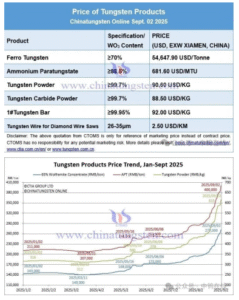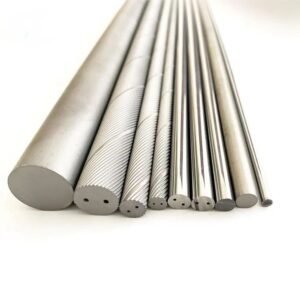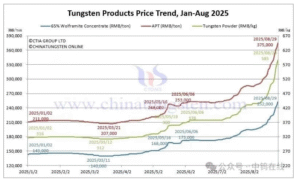Understanding the True Value Behind the Cost
In the world of precision machining and industrial manufacturing, tungsten carbide (also known as cemented carbide or simply “carbide”) is widely recognized for its exceptional hardness, wear resistance, and cutting performance. It is the preferred material for cutting tools, wear parts, dies, and mining tools. However, many purchasing managers and distributors often ask the same question:
“Why is tungsten carbide so expensive?”
This article will explain in detail the key factors behind the cost of tungsten carbide, helping buyers understand not just how much it costs, but more importantly, why it’s worth the investment.
1. Raw Material Scarcity: A Limited Natural Resource
The primary reason for the high cost of tungsten carbide lies in its core ingredient: tungsten. Tungsten is a rare metal that does not exist in its pure form in nature. It must be extracted from scheelite (CaWO₄) or wolframite ((Fe,Mn)WO₄) ores, which are found only in limited regions globally.
Currently, over 80% of the world's tungsten supply comes from China, giving the country significant control over global pricing. This geographic concentration of resources creates price instability, especially when there are supply chain disruptions, export regulations, or geopolitical tensions.
In addition, the mining and refining of tungsten are energy-intensive and environmentally regulated, further increasing production costs.
2. Complex Manufacturing Process: From Powder to Precision
Unlike steel or aluminum, tungsten carbide is not a single metal but a composite material. It is produced through a high-precision process known as powder metallurgy, which includes several stages:
- Refining tungsten ore into pure tungsten powder
- Mixing it with high-purity carbon to form tungsten carbide (WC) powder
- Adding metallic binders such as cobalt or nickel
- Pressing the powder into molds
- Sintering at temperatures up to 1,400–1,500°C to create solid carbide components
This process requires state-of-the-art equipment, strict environmental control, and high technical expertise, all of which contribute to the final product cost. At Zhuzhou Zhirong, we use 100% virgin tungsten carbide powder, ensuring purity, consistency, and long tool life, especially important for high-precision machining.
3. Use of Expensive Binders: Cobalt and Nickel
Tungsten carbide products are typically made of 85–95% tungsten carbide powder and 5–15% metallic binders, mainly cobalt (Co) or nickel (Ni). These binders not only hold the material together but also determine the toughness, impact resistance, and thermal stability of the cutting tool.
However, both cobalt and nickel are strategic, high-cost metals. Cobalt, in particular, is in high demand for use in batteries and aerospace applications, which drives its price even higher. Global supply of cobalt is also limited and politically sensitive, as much of it is sourced from the Democratic Republic of Congo.
As a result, the rising cost of cobalt and nickel significantly affects the cost of carbide inserts and tools.
4. Superior Performance: Long Life, High Precision, and Reliability
Despite its cost, tungsten carbide provides excellent value over time because of its unmatched performance. Key advantages include:
- Extreme hardness (second only to diamond)
- Superior wear resistance, which extends tool life
- High cutting speeds and excellent heat resistance, enabling efficient machining
- Precision and dimensional stability, reducing errors and downtime
In demanding industries such as automotive, aerospace, mold-making, and energy, tool failure can lead to production stoppages, rejected parts, and high maintenance costs. By choosing carbide tools, companies can reduce tool changes, improve product consistency, and increase output—offsetting the higher upfront investment.
5. Strong Demand Across Multiple Industries
Tungsten carbide is considered an indispensable industrial material. Its demand remains strong across multiple sectors:
- CNC machining and metal cutting
- Mining and construction
- Oil and gas drilling
- Aerospace and defense
- Mold and die manufacturing
These industries require consistent, high-performance tools that can operate under harsh conditions. As a result, carbide remains in high demand, and the global market continues to grow—especially in developing countries where industrialization is accelerating. Strong demand contributes to price stability at a higher level.
6. Quality Control, Certifications, and Customization
Top-quality carbide tools are produced under strict quality control systems, often certified to ISO standards. Manufacturers like Zhuzhou Zhirong Advanced Materials Co., Ltd. also invest in:
- Micron-level precision grinding equipment
- Inspection labs with CMM, hardness testers, and metallographic analyzers
- Custom tooling services based on specific customer needs
These efforts increase production costs, but they ensure that every insert or end mill performs reliably and consistently, even in the most demanding cutting conditions.
Conclusion: Expensive, But Worth It
Tungsten carbide is expensive due to a combination of raw material rarity, complex production, expensive binders, and high performance standards. However, its longer tool life, higher productivity, and reliability make it a cost-effective solution in the long run, especially in precision-driven industries.
At Zhuzhou Zhirong, we help our customers maximize value by offering:
- Cutting tools made from 100% virgin tungsten carbide powder
- CVD and PVD coated inserts for improved wear resistance
- Free samples (up to 10 pieces) for testing
- Technical support from engineers with over 15 years of experience
For more information or to request a quote, contact Crystal Yuan at
📧 crystalyuan@zrzhirong.com
🌐 www.zhirongcarbide.com
Let us help you choose the right tools to reduce cost per part, increase output, and achieve consistent quality in your machining operations.





